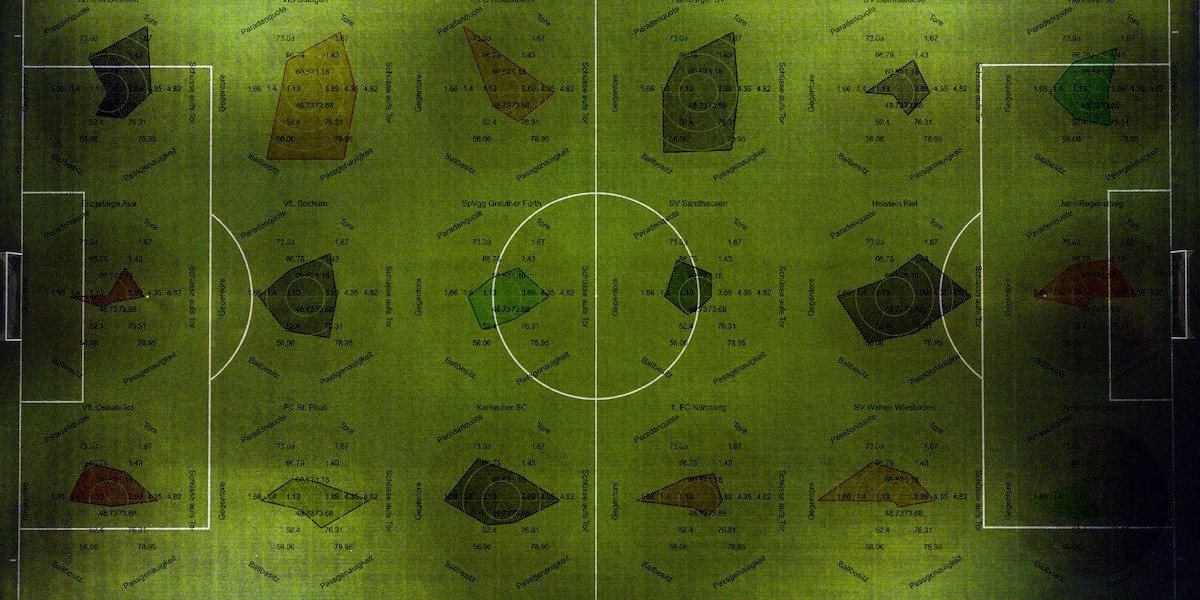After last season Arminia Bielefeld completely deserved their promotion to the German Bundesliga.
They combined both, the bes offence league-wide as well as the best defence league-wide.
Additionally, Arminia showed the most constant performance of all teams during the course of the season.
Bielefeld did not loose a single match in 2020 and just two loses were recorded during the complete season.
In the following, we analyze the average values of various statistics of the clubs of the past 2019/20 season.
We begin with explore the four best teams, then we analyze the four worst teams.
Eventually, a overview of all 18 second division teams is given.
In doing so, we look at the number of goals shot and conceded, the save percentage, the possession and the passing accuracy.
As mentioned Arminia Bielefeld combined the best offence and the best defence.
They did not need a lot of opportunities to shoot that many goals, which shows that they managed to get in a very good position often.
A little suprise is the relative low passing accuracy.
Actually, they had the worst passing accuracy of the first four teams of the league.
Probably, this is due to their approach of playing, since they tried create scoring opportunities by passing and also tried to solve every situation
by passing.
The low number of time of possession is because of the fact, that it was very difficult to play against Arminia.
Hence, the opponents possession was often on the not dangerous parts of the field in which the defending team often has no interest to play press.
Offensively, Stuttgart was the strongest club of the league, which is proven by the numbers.
The club of Heidenheim somehow surprisingly managed to qualify for the relegation match for promotion to the German Bundesliga.
The main reason for this was their strong defensive play, they conceded very few goals.
Furthermore, they had the highest save percentage of all teams.
This is not only due to a very good goalkeeper but also due to a very good back line, which rarely let the opponent get into promising scoring
positions with the ball.
Hamburg once more missed the promotion spots, which was the declared goal.
But in the deciding moments their defence was too shaky and with respect to the complete season, their performance was simply not good enough.
Lets take a look at the four worst teams of the past season of the 2. Bundesliga.
As expected, the opposite picture can be seen: notable less possession, less goals, many goals conceded, low passing accuracy.
It is notable that Karlsruher SC took that many shoots on the goal per game.
However, this did not result in many goals which indicates that they took shots from distant positions and, therefore, not from promising spots near
the goal.
Wiesbaden had the worst defence of the league, Dresden had the worst offence.
Both teams deserved the relegation.
On this overview of all 18 second division teams, ordered by their final placing, one can easily see the net which is spanned by the values morphs
to a gore pointing to more conceded goals the worse a team finished.
Often, the best teams had high values in the positive statistics as teams in the midfield of the table showed a smaller centered circle like
Greuther Fürth or SC Sandhausen.
Two facts are remarkable: one, Holstein Kiel had the most shots on target of all teams and two, Erzgebirge Aue had the lowest save percentage.
This is probably a combination of a bad performance of their goalkeeper and many great scoring opportunities for the opponents, caused by bad
defensive play.
‘The best thing for them to do is to stay at 0-0 until they score the goal.’ - Martin O’Neill
